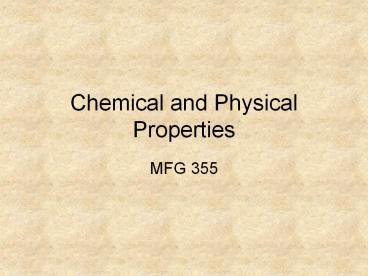Chemical and Physical Properties - PowerPoint PPT Presentation
1 / 35
Title:
Chemical and Physical Properties
Description:
Chemical and Physical Properties MFG 355 Ultraviolet (UV) Light Degradation Oxidation Plastic paint Chemical resistivity and solubility Chemical Resistivity and ... – PowerPoint PPT presentation
Number of Views:197
Avg rating:3.0/5.0
Title: Chemical and Physical Properties
1
Chemical and Physical Properties
- MFG 355
2
Ultraviolet (UV) Light Degradation
3
Oxidation
- Plastic paint
4
Chemical resistivity and solubility
Dissolving
None
Reacting
Swelling/softening
Nylon and H2O PVC and ketone
PVOH and water
Cellulosics and acids
PE and H2O
Increasing Chemical Reactivity to Plastic
5
Chemical Resistivity and Solubility
- PS exposed to gasoline
6
Chemical Nature and Solvent-solute Interactions
- Polar effects
- Like with like
- Steric effects
- Crystallinity
- Physical property effects on solvent-solute
interactions - Solvent size
- Swelling
7
Like to like polar polymer
8
Thermodynamics of Solvent Interactions
- Equation
- ?G ?H T?S
- Negative ?G is favorable
- Negative ?H means bonds are forming
- Positive ?S is standard (increasing)
- When does each term dominate to give a negative
?G?
9
Plasticizers
- Increase swelling
- Randomness
- Plasticizers can migrate out
10
Solvent Welding
11
Water Repellent
- Surface tension must be LOW
- Silicones 24 dyne/cm
- PTFE 19 dyne/cm
- PVC 37 dyne/cm
- Water wicking
12
Corrosion-Resistant
- Availability of electrons
- Polymers are better than metals
- Fluoropolymerstightly attached
- Electron shielded
- Chlorine attachment (blocks electron availability)
13
Coatings
- Decorative and protective
- Adhesion
- Weatherability
- Water solubility
14
Environmental Resistance and Weathering
15
Environmental Stress Cracking
- Hawaii Story
- Crosslinked, LLDPE
- Banana Plantation
- Drawdown
16
Crazing
- Cracks at stress areas
17
Permeability
- Diffusion Coefficient
- D Doe-A/RT
- Ficks Laws of diffusion
- J -D dc/dx
- Barrier Properties
- dc/dt D d2c/dx2
18
Gas (vapor) Permeation
- Polar groups (solubility) to solvent or gas
- Intermolecular size (distance)
- Crosslinking and crystallinity
19
Electrical Properties
- Resistivity (1018 10-6)
- Dielectric Strength
- Arc Resistance
- Dielectric Constant
- Dissipation Factor (heat up)
20
Conductive Polymers
21
Conductive Polymers
22
Optical Properties
- Light Transmission
- Clear
- Translucent
- Opaque
- Colorants
- Dyes
- Pigments
- Surface Reflectance
23
Transparency
- Non-crystalline
- Index of refraction low
- Total luminous transmittance high
24
Plastic Identification
- Spectroscopy
25
Flammability
- Self-extinguishing
- Halogen effects (oxygen)
- Fillers (Al2O33H2O) (heat)
- Aromatics (fuel)
- Silicones (fuel)
Heat
Fuel
Oxygen
26
Flammability Tests
- Vertical and horizontal burn tests
27
Limiting Oxygen Index
28
Flammability Tests
- Radiant panel
- Cone calorimeter
29
Flexibility
- CH2, O are flexible
- PE, Polyisoprene, PEO, Siloxanes
- Polybutylene terephthalate is more flexible than
PET - Pendant groups
- Crystallinity reduces flexibility
- Copolymers
- Plasticizers (soluble)
30
Heat Resistance
- Stiffening groups along the chain
- Phenyl groups
- Tg goes up since it takes more heat to move
molecules - Strong intermolecular H-Bonding
- Crystallinity increases heat resistance
31
Insulating Polymers
- Non-polar is better
- Foams
- Air is an insulator
32
Toughness
- Backbone Structure
- Pendant Groups
33
Thank You
34
Flammability Tests
- Limiting oxygen index (LOI)
35
Adhesives
- Bonding (chemical) between surfaces is best
- Crosslinking agents (ie siloxanes)
- Solvent based
- Latex adhesives good flow into crevices for
mechanical attachment - Pressure-sensitive polymer flow (mechanical)
- Hot melt polymer flow
- Reactive low molecular weight to get stronger
- End Groups

